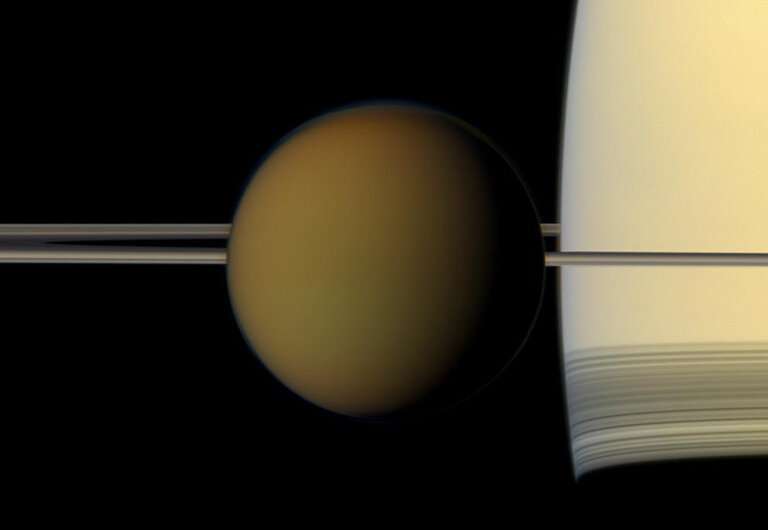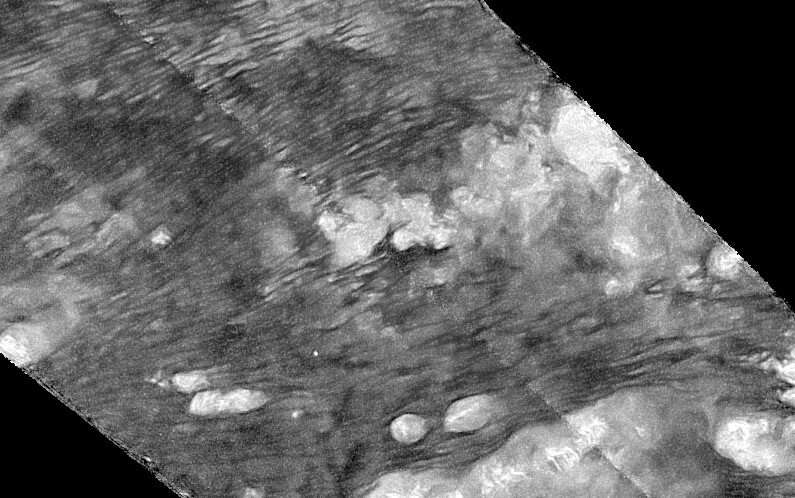Dust devils may roam hydrocarbon dunes on Saturn's moon Titan

Meteorological conditions on Saturn's large moon Titan, the strange, distant world that may be the most Earth-like in the solar system, appear conducive to the formation of dust devils, according to new research in AGU's journal Geophysical Research Letters.
If true, these dry whirlwinds may be primary movers of dust on the surface of Titan, as they are on Mars.
The Cassini spacecraft, which toured Saturn's system from 2004 to 2017, observed dunes in the moon's equatorial region covering as much as 30% of the surface and a large dust storm.
The dust on Titan's dunes is believed to originate as hydrocarbon aerosols raining out of the moon's atmosphere, according to Brian Jackson, a planetary scientist at Boise State University in Idaho and the lead author of the new study. It likely has a plasticky texture unlike the more familiar grit found on Earth or Mars.
Rare, big dust storms look impressive, but dust devils loft more total dust into the atmosphere, even on Earth, where winds are more influential than on Mars or Titan.
"Winds at the surface of Titan are usually very weak. Unless there is a big storm rolling through, there's probably not that much wind, and so dust devils may be one of the main dust transport mechanisms on Titan—if they exist," Jackson said.
Dust devils have not been observed on Titan. The authors of the new study predicted the possible presence of dust devils by applying meteorological models to data acquired from the moon's surface during the brief visit of Cassini's Huygens probe in 2005.

Dusty mystery
Dust devils form in dry, calm conditions when sunlight warms the ground and near-surface air. Rising warm air creates vortices made visible by sand and dust caught up in the whirl. Dust devils share some physical properties with tornadoes but are always dry and do not grow as large and destructive. But scientists don't entirely understand how dust devils work.
"When we plug the numbers in for how much dust the dust devil ought to lift based on the wind speeds we see, they seem to be able to lift more dust than we would expect. There may be some other mechanism which is helping them pull this dust—or the equations are just wrong," Jackson said.
Jackson and his students have chased dust devils across southeastern Oregon's Alvord Desert with small airborne drones carrying meteorological instruments, in an ongoing effort to get a look inside.
Exceptionally dry conditions on the Red Planet beget many dust devils during Martian summers, when they can grow immense, reaching 8 kilometers (5 miles) high. Mars' atmosphere is so thin even 200-mile-an-hour winds only cause a gently buffeting. This makes the dust-lifting power of dust devils important to the global movement of dust on Mars.
"We can watch dust devils skitter across the surface of Mars and see what their internal structure is like, but that doesn't tell us how much dust they are lifting. Mars' atmosphere is really, really dusty and dust plays an important role in the climate. Dust devils are probably, if not the dominant mechanism, one of the most important mechanisms for lofting the dust," Jackson said.
If they exist on Titan, dust devils may be similarly important, although winds at the surface of Titan are typically gentle for the opposite reason: Titan's atmosphere is one and a half times the density of Earth's, but the moon has only one seventh of Earth's gravity. This makes Titan's atmosphere hard to get moving, according to Jackson.
"It's just this enormous, puffy atmosphere. When you've got that much air it's hard to get it churning. So you just don't usually get big winds on the surface of Titan so far as we know," said Jackson.

Like Earth's, Titan's atmosphere is mostly nitrogen, but it also includes influential amounts of ethane and methane, the major components of natural gas. Titan is the only world in the solar system other than Earth where scientists have observed evidence of flowing rivers and liquid surface lakes, but scientists believe these Earth-like features on the cold, distant moon are not water but liquid hydrocarbons.
Confirmation of the new study's dust devil prediction may have to wait on the arrival of NASA's Dragonfly mission in 2034. Jackson says buffeting from dust devil encounters would be unlikely to trouble the large octocopter as it explores the moon's surface.
More information: Brian Jackson et al. Dust Devils on Titan, Journal of Geophysical Research: Planets (2020). DOI: 10.1029/2019JE006238
Journal information: Geophysical Research Letters
Provided by American Geophysical Union
This story is republished courtesy of AGU Blogs (http://blogs.agu.org), a community of Earth and space science blogs, hosted by the American Geophysical Union. Read the original story here.





















